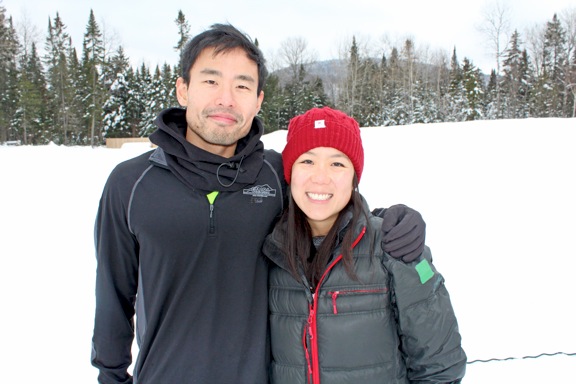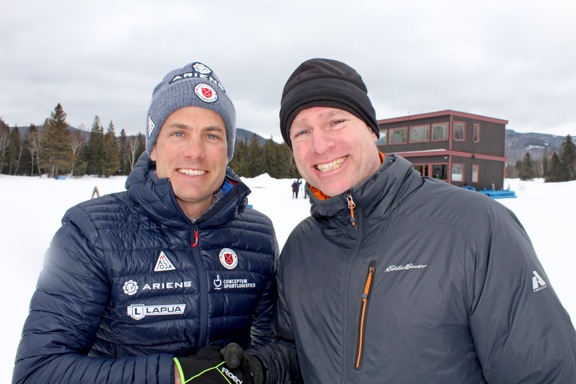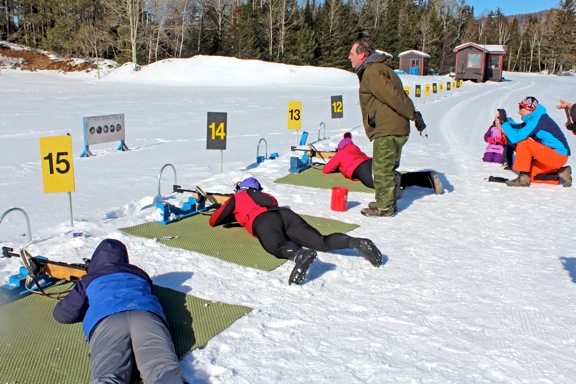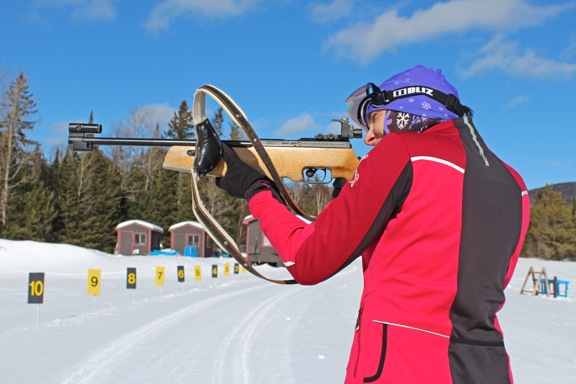ON THE SCENE: Tim Burke helps visitors be a biathlete for a day

Jeff Lu and Cindy Huang (Provided photo — Naj Wikoff)
The most-watched sporting event in the world is well-known, soccer. Ever wonder what’s in second place? It’s not American football, baseball, golf, tennis or cricket. It’s a sport a few local Olympians like Tim Burke and Annalies Cook excel at: biathlon. It has more than 900 million fans.
That’s more people watching than football, baseball, basketball, hockey and NASCAR combined.
Perhaps the madness of it accounts for the allure. You cross-country ski as fast as you can around a hilly loop carrying a 16.5-pound rifle on your back, whip it off and, with your heart racing at about 180 beats per minute, either standing or prone blast away at five targets in less than 30 seconds. Then, you do it all over again three more times. If you miss a target, you get to ski a 150-meter penalty loop, miss two times, ski the loop twice, then try again now back on the course more tired than you were before.
“When you go around the loop, which takes about 35 seconds, your heart and lungs now have to work harder,” said David Gardner, the affable and informative lead instructor for the general public at the state Olympic Regional Development Authority’s biathlon range at Mount Van Hoevenberg. “As a result, it’s going to be harder to make the shot when you next come into the range because you had to make that extra penalty loop. That’s why these athletes shoot 14,000 shots a year in practice; a missed shot exacts a stiff price. I asked one of the coaches what causes them to miss a shot, he said, thinking about the shot. Every time they pull that trigger, that shot no longer matters. There is only one thing that matters — the next shot.”
Imagine also if you are one of about 1,800 Americans who take up this sport, like Tim and Annalies. When you race here, you have not much more than family and friends cheering for you. Race in Norway or some other European country, you race in front of 20,000 to 40,000 rabid bell-ringing fans. At the same time, every move you make is broadcast live to millions of people watching and analyzing every aspect of your effort.

Olympian Tim Burke, left, and Chris Blomgren (Provided photo — Naj Wikoff)
What’s the secret to winning? Controlling your breath. Using your breath to help you become rock steady in the few seconds you have to cock, aim and fire your gun. Think Tom Brady is famous? He doesn’t hold a candle to Norwegian Ole Einar Bjoerndalen, who at age 40 won gold in the 10k sprint at the 2014 Sochi Winter Olympics, his seventh Olympic gold medal and 12th overall.
Bjoerndalen’s age underscores a point; it takes time to learn how to control your breath while shooting five bullets in quick succession as your heart is pounding away. No question younger athletes can ski faster than Bjoerndalen; what he doesn’t do very often is miss or get flustered.
Good news for people in our region, visitors and locals alike, is that you can try out the sport of the Olympic Sports Complex as I did Sunday, Feb. 16 during the 40th Anniversary of the 1980 Winter Olympics. I wasn’t alone, lots of people of varying ages, men and women, were out on the biathlon range blasting away, some with great success.
The roots of biathlon go back thousands of years to when early Scandinavians first created skis, enabling them to hunt deer in winter, be it with a spear or bow and arrow as illustrated in ancient cave drawings found in Norway. The advent of the rifle along with improvements made hunting on skis even more effective, an ability quickly adopted by the military as documented by the ski units used in the Second Northern War 1700-21. The first recorded competition took place within patrol companies along the Norway-Sweden border in 1767.
In 1861, the Norwegian Trysil Rifle and Ski Club, the first of many biathlon clubs, was established with others quickly following throughout northern Europe. Biathlon was an official sport in the first Winter Olympics held in Chamonix, France, in 1924. It was called military patrol. That said, it took three Olympic demonstrations (1928, 1936 and 1948) before the Union Internationale de Pentathlon Moderne et Biathlon was created to organize, standardize and promote the sport leading to its inclusion in the 1960 Games (for men) with a women’s division added not until 1992 in Albertville, France. Reflecting the sport’s historical and ongoing connection to the military, during the three-quarters of the 20th century, biathletes used full-bore 3.08 rifles, and the length of the range could be from 100 to 250 meters. Then in 1978, the .22 was made standard, the length of the range was reduced to 50 meters, and the targets set at 115mm for standing and 45mm for prone, about the size of a golf ball.

David Gardner, biathlon shooting instructor, oversees the shooters at Mount Van Hoevenberg. (Provided photo — Naj Wikoff)
The biathlon rifle has an ergonomic design developed for both the standing and prone positions, a distinct thumb rest, a built-in sling for carrying, and includes pouches in the stock for four, five-bullet clips. There are two variants, the German Anschtz 1827 Fortner and the Russian Izhmash 7-3 and 7-4, which is used by ORDA for its demonstration program.
Over at the biathlon range on Feb. 16, participants had the added treat of meeting local Olympic biathlete Tim Burke. He shared the experience of his four-Olympic journeys and being the first American to lead the overall World Cup, win a silver at the World Cup, and have six podium finishes.
“I started in cross-country,” said Burke. “I’d be out here at Van Hoevenberg training with the cross-country team, skiing by the biathlon range and seeing people out here on skis shooting at targets. As a 12-year-old boy learning that I could ski and shoot at the same time, nothing sounded better to me than that. The challenge of the sport is so much can change from day to day. Competing at the top level, you can be in 70th place one day and on the podium the next. That’s the challenge and also what keeps you going.”
Meryl Raddatz of Ottawa, Ontario, said shooting guns and skiing at an Olympic venue sounded cool, so she and her husband Bill signed up.
“This is really hard, but then I got the next nine,” said Meryl. “It was lots of fun. David’s a good instructor. When he says, look at the white ring around the dot, that made a difference. Now I want to take up the sport. I really do.”

Meryl Raddatz of Ottawa tries shooting. (Provided photo — Naj Wikoff)
Another was Army veteran Chris Blomgren, of Rochester, who described how the biathlon gun is different than an M-16.
“It had a very different feel, especially on the pistol grip and having the fist underneath,” said Bloomgren. “I made my shots, of course, I didn’t just ski five kilometers. That would have made a big difference. I don’t think I would have made too many then.”
For those who don’t have snow in their backyard who find this sounding interesting, not to worry. Snow isn’t a requirement. As athletes train in the summer on roller skis, the general public can try out the sport in the warmer months. More so, biathletes are pushing to have the roller ski version added to the Summer Olympics. If that happens, expect a corresponding surge in participants and fans.




